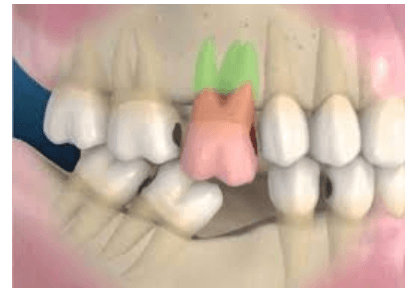Missing and Unrestorable Teeth
Back to: Clinical Team Procedures
CONDITION: Extreme Cavity/Non-Restorable Teeth
Often times a patient presents with “extreme cavity” on a tooth or multiple teeth. This may be in conjunction with large peri-apical abscesses. The purpose of this section is to share pictures and x-rays of teeth where it may make more sense to remove the tooth and opt for implant therapy as opposed to being “heroic” and performing crown lengthening, root canal, buildup and crown. The choice is ultimately up to the patient but our doctors need to advise the patient and explain to them on the treatment that is ultimately in their best interest.
How long will this heroic dentistry last?
What’s the fee difference between trying to save a compromised tooth versus taking the tooth out versus implant treatment?
Does the patient really want to adopt lifestyle changes such as cessation of smoking, more frequent recall appointments and most importantly changes in their diet and home care regimen?
Also when being an advocate for the patient in situations like this, make sure your judgement is not skewed by your own clinical skill set. You may not be well versed at placing dental implants. This isn’t enough of a reason to steer a patient away from this treatment option, especially if it’s the obvious best option for the patient.
Conversely, if you are focused in implants, there are still times that a bridge is appropriate. We need to make sure that we are using all the tools we have at our disposal to give the best outcome for the patient.
Think about comprehensive dentistry. Are you just focusing on one tooth? What does the rest of the mouth look like? What will be needed in the near future? Make sure the patient knows the full picture, so we aren’t just constantly patching one thing after another. We don’t want to play “wack-o-mole” dentistry.
Condition
Extreme Cavity/Non-Restorable Tooth
Treatment Plan
Implant, Bridge?, Nothing?
CONDITION: Missing Teeth
Our office strongly recommends that all patients replace missing teeth from first molar forward. Ideally this is done in a fixed manner, via implants or bridgework. Implants are the most ideal option to replace missing teeth. CBCT’s are needed to determine if enough bone is available to utilize implants. Bridgework would not normally be recommended in one or both abutments are virgin teeth. The exception to this guideline is when implants are contraindicated for the patient.
Replacing missing teeth is strongly encouraged but is considered PREVENTATIVE treatment. What eventually happens when missing teeth are not replaced? We need to be ready to have these conversations with patients. It is our job to educate them to the future problems that will occur. This is in the patient’s best interest BUT as a professional office we are legally and ethically responsible to inform them of the ramifications of not replacing missing teeth.
Below are some tools we use to educate and inform patients about these problems. Some of the problems that we see everyday when a missing tooth is not replaced:
- Over-eruption of opposing teeth
- Spacing develop
- Periodontal problems to food impaction from over-eruption
- Root caries
- Bone loss in area of missing teeth
- Lack of facial soft tissue support




